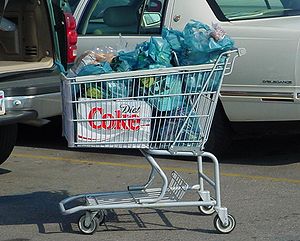Save big when you use these 25 savvy food shopping tips to help you cut grocery costs. These tips are so hot, you just may want to share them with your family and friends.
25 Supermarket Savvy Shopping Tips
1. Get to know your food store(s). Be loyal to any store that provides the best deal. Get better deals on more food by shopping in more than one store.
- There are foods that maybe less expensive in certain stores all the time.
- Do they offer store or double coupons?
- Are there coupons online?
2. Get to know your store managers: The meat dept. may have weekly “managers specials”, the fruit/vegetable dept. and bakery are more likely to mark things down at the end of the day. The staff can tell you when to shop to save the most.
3. Circulars give you a snapshot of what’s on sale. Browse the sales then build a shopping list, stick to the list.
4. When meat or non-perishables are on sale try to buy enough so that it lasts until the next sale, how will you know when the next sale on an item is? Track it yourself (usually every 2-4 weeks) or see #2.
5. Coupons, coupons, coupons: if you do it right, the store pays you to take their groceries. The coupon project is a great resource, http://thecouponproject.com/2011/04/how-to-use-coupons-secrets.html. Keep in mind, some stores except their competitors coupons.
6. For paper goods, don’t wait ’til the last minute or last few sheets of toilet paper are left to buy more. These items are usually more expensive at grocery stores (unless you use rule #4) so compare your grocery store with a big chain like Walmart, target or BJ’s before your spend more. Look carefully some items may be more expensive but these retail stores may even run sales on groceries.
7. Get more out of your food by using chicken and other meats to make broth/soup instead of buying a can.
8. Make it yourself, do not buy pre-cut or pre-prepared food items, your labor is less costly than theirs.
9. Using leftovers, saves cooking and cleaning time. It also leaves less of an ecological footprint by using less gas for cooking, less energy, water…
10. Shop in your own pantry, it’s free. Use up your food on the shelves before buying more.
11. Eat before you shop. Do not shop when you are hungry, you will likely buy more food. But, if you are hungry while shopping for food stick to the veggie aisle.
12. Stores are in business to entice you to spend money. The stores are strategically organized so that you have to walk through the aisles of “extras” to get to the food staples like meat, and milk. Keep your blinders on and move fast, try not to fall into this trap.
13. If you do walk down the wrong aisle, like snack chips for example, be smart. How many chips are you going to get in a 2 for $5 deal? Half the bag you are paying for is air. You actually just paid $5 for 1 bag chips. Not a good deal!
14. Just say NO! If you bring kids with you, your food bill will escalate as fast as a blink of an eye. Maybe just leave them at home. Or, agree on what they can buy before you go shopping and make it a learning experience.
15. Do not read the tabloids as your food goes down the conveyor. While reading all the gossip, you miss your chance to catch the food stores many mistakes (either mislabeled or cashier key-in ). I catch a few almost every week, so keep an eye on your goods.
16. You do not have to be an accountant but you should have access to a calculator. Check the unit prices. Compare these with sales or coupon items. The cost per item may be more but the unit price may be less.
17. Generic brands are more affordable and do not necessarily translate into less quality, less taste. Once you take it out of the can, it all looks the same.
18. Higher priced items on sale maybe less expensive or the same price as a generic brand.
19. Larger size does not always mean better price. Sometimes small sizes that are on sale will yield more in total quantity and still be cheaper when on sale.
20. Scan all the shelves before you make your final choice. Lower cost items are usually placed on higher or lower shelves. More expensive items are conveniently placed right at eye level.
21. Grow your own garden. Your garden fresh food is better quality and cheaper than you’ll ever get from any store.
22. Frozen fruits and veggies can cost less and are just as nutritious.
23. Toiletries and other personal care products are not better priced at the grocery store, unless of course you have a coupon or sale.
24. Seasonal deals are not just for cloths. Coupons are abundant in November and December just around the holidays. Just after the holidays, certain foods will be cheaper. Candy right after Halloween and Valentine’s Day. Turkey, stuffing and cranberries after Thanksgiving. You can buy decorating kits for Easter after the holiday and use it for the following year.
25. Stick to portion sizes. Improve your waistline and save money by sticking to recommended portion sizes.
Related articles
- How To Cut Your Grocery Costs By 10% or more (debtconsolidationusa.com)
- How to Beat High Grocery Store Prices (danielletjackson.wordpress.com)








Reblogged this on Valerie's Voice: For the Health of It.